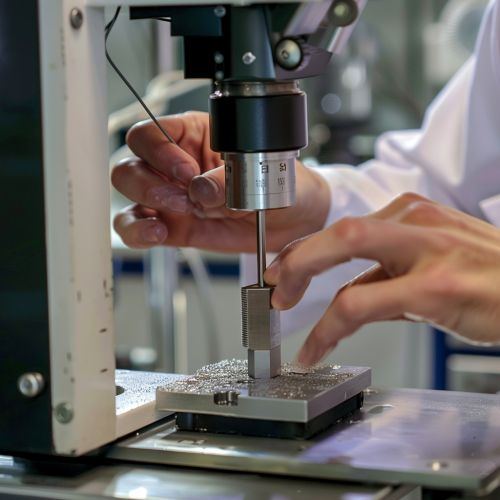Hardness
Hardness
Hardness is a measure of a material's resistance to deformation, particularly permanent deformation, scratching, cutting, or abrasion. It is a critical property in materials science, engineering, and metallurgy, influencing the selection and application of materials in various industries.


Definition and Importance
Hardness is defined as the resistance of a material to localized plastic deformation. This property is crucial in determining a material's suitability for various applications, including construction, manufacturing, and tool-making. Hardness is not a fundamental property but rather a composite one that encompasses various factors such as strength, ductility, and toughness.
Types of Hardness
Hardness can be categorized into several types based on the method of measurement and the type of deformation:
- **Indentation Hardness**: This measures the resistance of a material to deformation from a sharp object. Common tests include the Brinell, Rockwell, and Vickers hardness tests.
- **Scratch Hardness**: This measures the resistance of a material to scratching. The Mohs scale is a well-known method for measuring scratch hardness.
- **Rebound Hardness**: This measures the height of the "bounce" of a diamond-tipped hammer dropped from a fixed height onto a material. The Shore scleroscope is commonly used for this type of hardness.
Measurement Techniques
Several techniques are employed to measure hardness, each with its specific applications and limitations:
- **Brinell Hardness Test**: This test involves pressing a hard steel or carbide ball into the material and measuring the diameter of the indentation. It is suitable for materials with coarse or uneven grain structures.
- **Rockwell Hardness Test**: This test uses a diamond cone or hard steel ball indenter and measures the depth of penetration under a large load compared to the penetration made by a preload. It is widely used due to its speed and simplicity.
- **Vickers Hardness Test**: This test uses a diamond pyramid indenter and measures the diagonal length of the indentation. It is suitable for thin materials or coatings.
- **Knoop Hardness Test**: Similar to the Vickers test but uses an elongated diamond indenter, making it suitable for brittle materials or thin layers.
Factors Affecting Hardness
Several factors influence the hardness of a material:
- **Composition**: The chemical composition of a material significantly affects its hardness. For example, the addition of carbon to iron increases the hardness of steel.
- **Microstructure**: The arrangement and size of grains within a material can influence its hardness. Fine-grained materials are generally harder than coarse-grained ones.
- **Heat Treatment**: Processes such as quenching and tempering can alter the hardness of metals by changing their microstructure.
- **Work Hardening**: Also known as strain hardening, this process increases hardness through plastic deformation.
Applications of Hardness
Hardness is a crucial property in various applications:
- **Cutting Tools**: Materials with high hardness are essential for cutting tools to maintain sharp edges and resist wear.
- **Wear-Resistant Surfaces**: Hard coatings and surface treatments are used to enhance the wear resistance of components in machinery and equipment.
- **Structural Materials**: Hardness is a key factor in selecting materials for construction and structural applications to ensure durability and longevity.
Hardness in Different Materials
Different materials exhibit varying degrees of hardness:
- **Metals**: Metals such as steel, titanium, and tungsten carbide are known for their high hardness and are widely used in industrial applications.
- **Ceramics**: Ceramics like alumina and silicon carbide have high hardness and are used in abrasive and cutting applications.
- **Polymers**: Polymers generally have lower hardness compared to metals and ceramics, but certain engineering plastics can exhibit significant hardness.
- **Composites**: Composite materials can be engineered to achieve a balance of hardness and other properties, making them suitable for specialized applications.
Hardness Testing Standards
Several international standards govern hardness testing methods to ensure consistency and reliability:
- **ASTM E10**: Standard Test Method for Brinell Hardness of Metallic Materials.
- **ASTM E18**: Standard Test Methods for Rockwell Hardness of Metallic Materials.
- **ASTM E92**: Standard Test Methods for Vickers Hardness and Knoop Hardness of Metallic Materials.
- **ISO 6506**: Metallic materials - Brinell hardness test.
- **ISO 6508**: Metallic materials - Rockwell hardness test.
- **ISO 6507**: Metallic materials - Vickers hardness test.
Advanced Hardness Measurement Techniques
With advancements in technology, new methods for measuring hardness have been developed:
- **Nanoindentation**: This technique measures hardness on a nanometer scale, providing insights into the mechanical properties of thin films and small volumes of material.
- **Instrumented Indentation Testing (IIT)**: This method records the force and displacement during indentation, allowing for the determination of hardness and other mechanical properties such as elastic modulus.
Challenges in Hardness Measurement
Despite its importance, measuring hardness presents several challenges:
- **Surface Preparation**: Proper surface preparation is crucial for accurate hardness measurements. Surface roughness, contamination, and coatings can affect the results.
- **Indentation Size Effect**: The hardness value can vary with the size of the indentation, particularly in micro- and nanoindentation tests.
- **Anisotropy**: Materials with directional properties can exhibit different hardness values depending on the orientation of the test.
Future Trends in Hardness Measurement
The field of hardness measurement continues to evolve with ongoing research and technological advancements:
- **Automated Hardness Testing**: Automation and robotics are being integrated into hardness testing to improve efficiency and reduce human error.
- **In-Situ Hardness Measurement**: Techniques for measuring hardness in real-time during manufacturing processes are being developed to ensure quality control.
- **Multifunctional Testing**: Combining hardness measurement with other mechanical tests, such as tensile or fatigue testing, to provide a comprehensive understanding of material properties.
